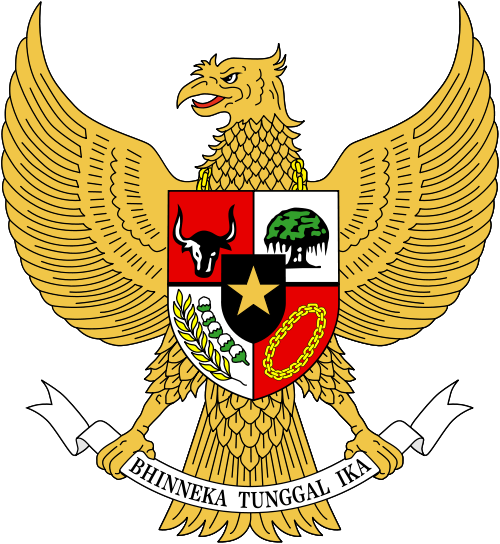 Garuda Pancasila
Garuda Pancasila Garuda Pancasila
Garuda Pancasila
| [ Last Update: Sunday, 16-May-2010 14:08:03 EDT ] |

The Garuda Pancasila is the coat of arms of Indonesia. The main part of the coat of arms is the Garuda with a shield on its chest and a scroll gripped by its leg. The shield's five emblems represent Pancasila, the five principles of Indonesia's national philosophy. Garuda Pancasila was designed by Sultan Hamid II of Pontianak, and was adopted as national coat of arms on 1 February 1950.
The Garuda clutches in its talons a scroll bearing the National Motto of Indonesia, "Bhinneka Tunggal lka" which is an Old Javanese stanza of the epic poem "Sutasoma" attributed to the 14th century poet sage of the Javanese Majapahit Empire, Empu Tantular. The text was re-desicovered by the Dutch scholar Brandes from among the many lontar manuscripts among the Dutch booty called the Lombok treasure — looted from the destroyed Lombok palace in 1894, who is said to have committed the phrase to writing for the first time.
The poem expounded a doctrine of reconciliation between the Hindu and Buddhist faiths: meaning literally literally meaning "Although diverse, both truthful to Dharma- thus there exists no duality in Truth". This spirit of religious tolerance was an essential element in the foundation and security of the newly emerging State of Majapahit and the thusly fledgling Republic of Indonesia. It is roughly rendered, Diverse, yet united or perhaps more poetically in English: Unity in Diversity.
The shield is a martial symbol, standing for defense of the country. It is divided into five sections: a background divided into quarters, colored red and white (the colors of the national flag) in a checkerboard pattern; and a smaller, concentric shield, black in background. A thick, black line lies horizontally across the shield, symbolizing the equator which passes through the Indonesian archipelago.
Each section of the shield has a symbol corresponding to the Pancasila principles laid down by its founder, President Sukarno.
This tenet of Pancasila has always been controversial, for it suggests compulsory religious belief as well as compulsory monotheism. Supporters of Sukarno's legacy, however, believe that this tenet was meant to unify Indonesia's population, who have diverse faiths and beliefs.